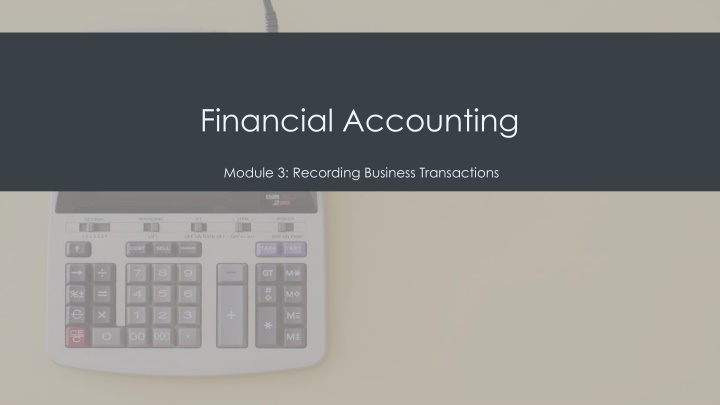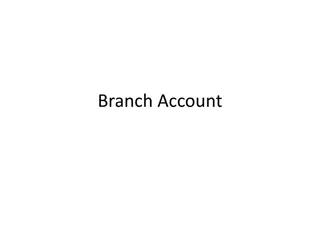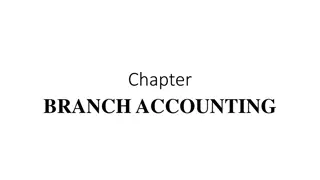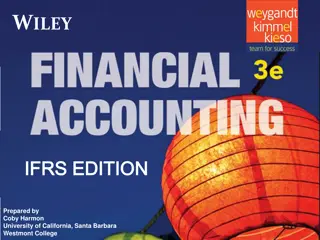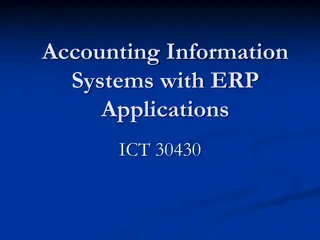Branch Accounting System Overview
Branch accounting involves maintaining separate accounts for each branch or operating location within an organization. It provides transparency in financial transactions, cash flows, and performance at individual branches. Learn how branch accounting works, methods used, and its historical significance.
Uploaded on Feb 24, 2025 | 0 Views
Download Presentation

Please find below an Image/Link to download the presentation.
The content on the website is provided AS IS for your information and personal use only. It may not be sold, licensed, or shared on other websites without obtaining consent from the author.If you encounter any issues during the download, it is possible that the publisher has removed the file from their server.
You are allowed to download the files provided on this website for personal or commercial use, subject to the condition that they are used lawfully. All files are the property of their respective owners.
The content on the website is provided AS IS for your information and personal use only. It may not be sold, licensed, or shared on other websites without obtaining consent from the author.
E N D
Presentation Transcript
Financial Accounting Module 3: Recording Business Transactions
Module Learning Outcomes Understand double-entry accounting 3.1: Identify the basic reporting structure of accounting information 3.2: Identify the accounting books of record 3.3: Account for business transactions using double-entry bookkeeping
A circle with the ten steps in the accounting cycle: 1. Analyze Transactions, 2. Prepare Journal Entries, 3. Post Journal Entries, 4. Prepare Unadjusted Trial Balance, 5. Make Adjusting Journal Entries, 6. Prepare Adjusted Trial Balance, 7. Prepare Financial Statements, 8. Prepare Closing Entries, 9. Prepare Post-Closing Trial Balance, and 10. Create and Post Reversing Entries, if needed. The Accounting Cycle Double-entry bookkeeping allows all stakeholders to get an accurate picture of operations Accountants follow a strict, well-defined process to provide this information
The Accounting Cycle (cont.) In this module, we ll cover the first four steps:
Learning Outcomes: Double Entry Bookkeeping 3.1: Identify the basic reporting structure of accounting information 3.1.1: Define accounts as they are used in bookkeeping 3.1.2: Explain the role of accounts 3.1.3: List the general rules for debits and credits
Accounts An account is a part of the accounting system used to classify and summarize a specific set of a business s transactions. Firms set up accounts for each different business element, such as cash, accounts receivable, and accounts payable. Accounts are categorized by type listed in this order: Assets Liabilities Equity, which is broken down into: Capital Withdrawals Revenue Expenses
The Role of Accounts We use accounts to track things that are important to us (using the monetary principle) and we try not to have more accounts than we need. Each account then will have a running total, called a balance that we, as bookkeepers, keep up to date and accurate.
Rules of Debits and Credits Double-entry bookkeeping is the foundation of accounting. In the double-entry system, every transaction affects at least two accounts, and sometimes more. Instead of using negative and positive numbers, we record our transactions in terms of debit and credit. Debits are on the left and credits are on the right.
Debits and Credits Example On April 1, Cheyenne Houghton opened a bank account in the name of her business, Cheyenne Creates, using $10,000 of her own money from her personal account. Checking Account, Cheyenne Creates Debit $10,000 Credit Cheyenne Houghton, Capital Debit Credit $10,000
Debits and Credits and the Accounting Equation On the left side of the accounting equation: Assets are increased by a debit, decreased by a credit On the right side of the accounting equation: Liabilities are increased by a credit, decreased by a debit Equity is increased by a credit, decreased by a debit
Practice Question 1 The Lazy Z company received an additional $20,000 in revenue in the last quarter from their sales of sleepwear. Being their accountant, you would record the increase in company revenue as a debit in ________ and a credit to ______ accounts. A. checking : revenue B. sales : cash C. revenue : inventory D. capital : accounts receivable
Learning Outcomes: Journals and Ledgers 3.2: Identify the accounting books of record 3.2.1: Identify a journal 3.2.2: Identify a ledger 3.2.3: Describe how a ledger is related to a T account
Journals A shorthand chronological list of transactions JOURNAL Page 1 POST. REF. DATE 20XX Apr. 1 DESCRIPTION DEBIT CREDIT Checking Cheyenne Houghton, Capital To record initial investment by owner and deposit to bank account 10,000.00 10,000.00 Apr. 4 Materials Expenses Checking To purchase materials to create pottery 3,000.00 3,000.00
Ledgers A ledger is another book, similar to the journal, but organized by account. A general ledger is the complete collection of all the accounts and transactions of a company. This is a German ledger from 1828.
GENERAL LEDGER Account: Checking Account No. 1100 BALANCE Ledgers (cont.) DATE ITEM POST. REF. DEBIT CREDIT DEBIT CREDIT 20 Oct. 1 a 199,846.33 Balance Oct 9 J41 12,315.64 187,530.69 This is a modern ledger Oct 20 J41 474.55 187,056.14 Oct 23 J41 12,376.89 174,679.25 Nov 4 J42 484.42 174,194.83 Nov 6 J42 32.00 174,162.83 Nov 6 J43 12,180.03 161,982.80 Nov 13 J43 1,494.06 160,488.74 Nov 16 J44 6,529.02 153,959.72 Nov 16 J44 1,212.21 152,747.51 Nov 16 J44 537.00 152,210.51 Nov 20 J44 9,425.15 142,785.36 Dec 3 J45 427.43 142,357.93 Dec 4 J45 10,970.92 131,387.01 Dec 9 J46 32.00 131,355.01 Dec 14 J46 2,194.72 129,160.29 Dec 15 J46 6,651.26 122,509.03 Dec 15 J46 1,219.11 121,289.92 Dec 18 J46 482.76 120,807.16 Dec 18 J46 14.70 120,792.46 Dec 18 J46 52,905.17 67,887.29
T Accounts A T account is just a simpler way to present a ledger You remove everything but the debit and credit columns
Learning Outcomes: Recording Process 3.3: Account for business transactions using double-entry bookkeeping 3.3.1: Analyze transactions and create journal entries 3.3.2: Post journal entries to a general ledger 3.3.3: Calculate the account balance 3.3.4: Prepare a trial balance
Create Journal Entries Let s take a look at a two transactions: On October 1, Nick opened a bank account in the name of NeatNiks using $20,000 of his own money from his personal account. October 4, Nick rented a truck for $12,000 cash for October thru March (6 months). Now, let s journalize these transactions
Create Journal Entries (cont.) JOURNAL Page 1 Date Description Post. Ref. Debit Credit 20 Oct. 1 Checking 20,000.00 Oct. 1 Nick Frank, Capital 20,000.00 To record initial investment by owner and deposit to bank account Oct. 1 Oct. 4 Prepaid Rent 12,000.00 Oct. 4 Checking 12,000.00 Oct. 4 To record prepayment of rent on vehicle
Post to the Ledger This process is largely automated in computerized accounting systems. Each account needs its own ledger all of these ledgers will come together to form the general ledger. Take a look at this transaction again: On October 1, Nick opened a bank account in the name of NeatNiks using $20,000 of his own money from his personal account. When we post from the journal to the ledger, we do exactly as the journal tells us. If we think it s wrong, we go back to whoever analyzed the transaction. When we post, we note the page of the journal so we can go back later and find our source if we need to. We note the account number in the POST. REF. column of the journal.
Post to the Ledger (cont.) GENERAL LEDGER Account: Checking Account No. 1100 BALANCE DATE ITEM POST. REF. DEBIT CREDIT DEBIT CREDIT 20 Oct 1 a 0.00 Balance Oct 1 GJ1 20,000.00 20,000.00 GENERAL LEDGER Account: Nick Frank, Capital Account No. 310 BALANCE DATE ITEM POST. REF. DEBIT CREDIT DEBIT CREDIT 20 Oct 1 a 0.00 Balance Oct 1 GJ1 20,000.00 20,000.00
Calculate Account Balances Ledgers include columns for account balances You calculate these balances by combining the credit and debit entries within the ledger GENERAL LEDGER BALANCE POST. REF. DATE ITEM DEBIT CREDIT DEBIT CREDIT 20 a 0.00 Oct 1 Balance Oct 20 GJ1 7,250.00 7,250.00 Oct 30 GJ2 1,600.00 5,650.00
Calculate Account Balances (cont.) The balance on October 31 is a debit of $5,650.00, calculated as follows: $- 7,250.00 (1,600.00) $5,650.00 Beginning balance debit entry credit entry Ending balance
NeatNiks Trial Balance (unadjusted) For the month ended October 31, 20XX Prepare a Trial Balance Ref No. Accounts Debits Credits 110 Checking 3,500.00 120 Accounts Receivable 5,650.00 To prepare a trial balance, you ll take all of the balances from your general ledgers and compile them into one table. Put all the debit balances in one column, and all the credit balances in another, and compare the totals. 125 Supplies 2,600.00 130 Prepaid Rent 12,000.00 210 Account Payable 1,600.00 220 Contractor Payable Nick Frank, Capital Contributions 310 20,000.00 330 Nick Frank, Withdrawals 4,000.00 410 Service Revenue 8,750.00 510 Insurance Revenue 1,500.00 520 Rent Expense 530 Supplies Expense 540 Contractor Expense 1,100.00 Totals 30,350.00 30,350.00
Practice Question 2 A trial balance is: A. A ledger where actions and events are placed in chronological order. B. Where the debits and credits are in one column and calculated together. C. Also known as a general journal where each type of account has its own section. D. Where all of the balances are taken from the general ledgers and compiled into one table.
Quick Review We went over the first four steps of the accounting cycle:
Quick Review What are the definitions of accounts as they are used in bookkeeping? Describe the role of accounts in financial accounting. How would you list the general rules for debits and credits? What is a journal? What is a ledger? How is a ledger related to a T account? How do you analyze transactions and create journal entries? What is the process of posting journal entries to a general ledger? How do you calculate the account balance? How do you prepare a trial balance?
